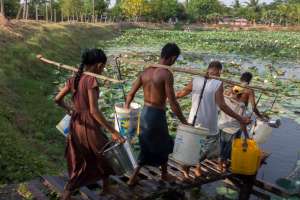
Myanmar opened a new chapter in its history in November 2010 when it adopted its open-economy policy. Since then, an impressive array of reforms has been implemented.
Excitement about this transition has been widely shared among political, economic, and investment communities around the world. However, Myanmar’s sustainable and inclusive growth depends on it maintaining this momentum during its transition—particularly inflows of foreign direct investment.
Maximizing impact of investment
The increase in foreign direct investment in recent years has indeed been impressive. Nonetheless, investment resources are inherently limited. In order to maximize the potential impact of investment for sustainable economic growth, it is pertinent to ask which industry is going to yield sustainable growth for Myanmar?
Albert O. Hirschman, one of the first major contributors to development economics, suggests that investing in industries should be based on the relative strength of industry linkages. He introduced the concept of backward and forward linkages. In a nutshell, a backward linkage exists when investments in the industry benefit its input markets, while a forward linkage exists when investments in the industry benefit its subsequent output markets.
Since many developing countries would like to develop domestic industries that supply inputs for exportable final products, Hirschman suggests investing in industries with a strong backward linkage. Some economists consider that the total industry linkage index should guide investment, as the industry with a high total industry linkage index is sensitive to the increase in final demand.
Applying Hirschman’s method to 26 industries in Myanmar, the most balanced industry for investments (i.e., offering relatively high forward and backward linkages and a high total industry linkage index) turns out to be the agriculture sector. Investments in agriculture will positively affect both input (e.g., fertilizer and agriculture machinery) and output (e.g., restaurants, hotels) markets, in addition to having a positive overall impact on the economy.
A $100 million investment in the agriculture sector would push up Myanmar’s GDP by 0.33%. This is a somewhat surprising result, as agriculture generally tends to have low forward and backward linkages among developing countries in general.
Myanmar’s economy is predominantly agrarian. Investing in agriculture will yield positive returns in upstream and downstream industries that are related to agriculture. Other ideal sectors for investments (using Hirschman’s methods) include the transport equipment sector and the food and beverages sector. These two sectors also have relatively high forward, backward and total linkages with other sectors.
The highest return from investments will come from the utility (i.e., electricity, gas, and water) sector. A $100 million investment in the utility sector would push up GDP by 0.43%. The utility sector has a strong backward linkage with transport and petroleum, chemical, and non-metallic mineral products. However, the forward linkage is almost nonexistent. This implies that industry outputs would not be utilized by domestic industries but will be exported away. The metal industry has similar characteristics, i.e., high backward and total linkages, but low forward linkages.
Heavy investments in the utility and mining industries will risk a situation where natural resource exports create an appreciation of the real exchange rate so that other potentially exportable industries become too expensive. This situation is often known as the “Dutch disease” or “resource curse.”
Given the limited investment inflows into the country, sectors to be invested in require careful scrutiny. In the process, policymakers need to identify options that would balance out the potential consequences from investments.
This article was first published by the ADB Development Blog [1].